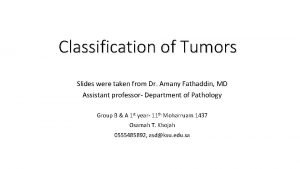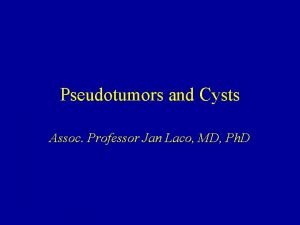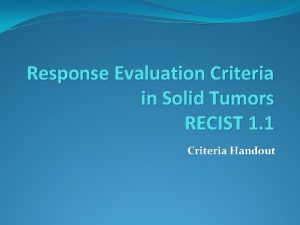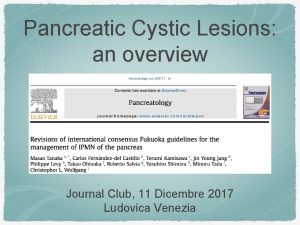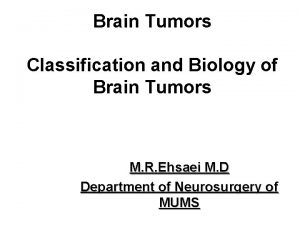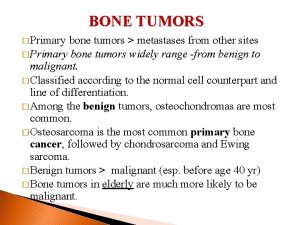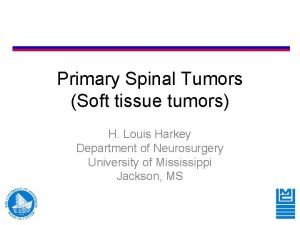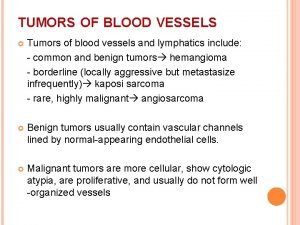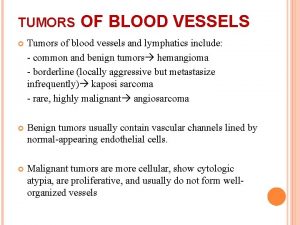Classification of Tumors Slides were taken from Dr





























































- Slides: 61

Classification of Tumors Slides were taken from Dr. Amany Fathaddin, MD Assistant professor- Department of Pathology Group B & A 1 st year- 11 th Moharruam 1437 Osamah T. Khojah 0555485892, asd@ksu. edu. sa



Objectives • Define the terms: neoplasm, tumor and oncology. • Classify tumors into benign and malignant. • Understand the concepts governing the classification of tumors and their nomenclature. • Define hamartoma, teratoma, choristoma and heterotropic rest.

General Definition • Neoplasia means “new growth, ” • Neoplasm is often referred to as a tumor. • Oncology (Greek oncos = tumor) is the study of tumors or neoplasms.

Classification of Tumors • Benign when its microscopic and gross characteristics are considered relatively innocent, implying that it will remain localized, it cannot spread to other sites, and it is generally amenable to local surgical removal; the patient generally survives. • Malignant implies that the lesion can invade and destroy adjacent structures and spread to distant sites (metastasize) to cause death.

Similarity • All tumors, benign and malignant, have two basic components: 1. Clonal neoplastic cells that constitute their parenchyma. 1. Reactive stroma made up of connective tissue, blood vessels, and variable numbers of macrophages and lymphocytes.

Important of Stroma • Although the neoplastic cells largely determine a tumor's behavior and pathologic consequences, their growth and evolution is critically dependent on their stroma. • An adequate stromal blood supply is requisite for the tumor cells to live and divide. • The nomenclature of tumors and their biologic behavior are based primarily on the parenchymal component.

Benign Tumors • In general, benign tumors are designated by attaching the suffix oma to the cell of origin. • Tumors of mesenchymal cells generally follow this rule. • For example, a benign tumor arising in fibrous tissue is called a fibroma, whereas a benign cartilaginous tumor is a chondroma. • Adenoma is applied to a benign epithelial neoplasm derived from glands, although they may or may not form glandular structures.

Benign Tumors • Benign epithelial neoplasms producing microscopically or macroscopically visible finger-like or warty projections from epithelial surfaces are referred to as papillomas. • Those that form large cystic masses, as in the ovary, are referred to as cystadenomas. Some tumors produce papillary patterns that protrude into cystic spaces and are called papillary cystadenomas. • Polyp is a mass that projects above a mucosal surface produces a macroscopically visible projection above a mucosal surface.

polyp

Malignant Tumors • Malignant tumors arising in mesenchymal tissue are usually called sarcomas. • Malignant neoplasms of epithelial cell origin, derived from any of the three germ layers, are called carcinomas. • Squamous cell carcinoma would denote a cancer in which the tumor cells resemble stratified squamous epithelium. • adenocarcinoma denotes a lesion in which the neoplastic epithelial cells grow in glandular patterns.

Malignant Tumors • Sometimes the tissue or organ of origin can be identified, as in the designation of renal cell adenocarcinoma. Not infrequently, however, a cancer is composed of undifferentiated cells of unknown tissue origin, and must be designated merely as an undifferentiated malignant tumor.

Malignant Tumors • In many benign and malignant neoplasms, the parenchymal cells bear a close resemblance to each other, as though all were derived from a single cell. However, • Divergent differentiation of a single neoplastic clone along two lineages creates what are called mixed tumors. The best example of this is the mixed tumor of salivary gland origin. These tumors contain epithelial components scattered within a myxoid stroma that sometimes contains islands of cartilage or bone. All these elements, it is believed, arise from a single clone capable of giving rise to epithelial and myoepithelial cells; thus, the preferred designation of these neoplasms is pleomorphic adenoma.



Teratoma • Teratoma, is a special type of mixed tumor that contains recognizable mature or immature cells or tissues representative of more than one germ cell layer and sometimes all three. • Originate from totipotential cells such as those normally present in the ovary and testis and sometimes abnormally present in sequestered midline embryonic rests. Such cells have the capacity to differentiate into any of the cell types found in the adult body. • When all the component parts are well differentiated, it is a benign (mature) teratoma; when less well differentiated, it is an immature, potentially or overtly, malignant teratoma.


Critical Exceptions • Benign-sounding designations such as lymphoma, melanoma, mesothelioma, and seminoma have been used for certain malignant neoplasms.

Critical Exceptions • Hamartomas present as disorganized but benign-appearing masses composed of cells indigenous to the particular site. For example, pulmonary chondroid hamartoma contains islands of disorganized, but histologically normal cartilage, bronchi, and vessels. • Traditionally been considered developmental malformations, but some genetic studies have shown the presence of acquired translocations, suggesting a neoplastic origin.

Critical Exceptions • Choristoma is a congenital anomaly consisting of a heterotopic rest of cells. For example, a small nodule of well-developed and normally organized pancreatic tissue may be found in the submucosa of the stomach, duodenum, or small intestine. It has usual trivial significance.

Summary • Although the terminology of neoplasms is regrettably not simple, a firm grasp of the nomenclature is important because it is the language by which the nature and significance of tumors are categorized. • Remember the exceptions…



Pathology • Fellowship of RCPA for Medical Graduates (apart from diplomas): ØAnatomical Pathology: (SP/HP), (in NA other clinical pathology). ØChemical Pathology (BC, MC, …). ØClinical Pathology. ØForensic Pathology. ØGeneral Pathology. ØGenetic Pathology. ØHaematology. ØImmunopathology. ØMicrobiology.

Hematology & Immunology • Clinical: Medicine or Pediatric. • Pathology: NA or UK/AU, Residency, Ph. D. • Research: transitional/basic…

KSF Pathology Programs • Hematopathology & Blood Transfusion: v Bone Marrow report: Leukemia & some lymphoma and others. v Peripheral blood smear and other routine hematology lab (core lab): cytology & HE. v Coagulation tests and anti-coagulant clinic: v Transfusion Medicine & cellular therapy in future. v. Laboratory administration and quality management.

Properties of Benign and Malignant Neoplasm Slides were taken from Dr. Amany Fathaddin, MD Assistant professor- Department of Pathology Group B & A 1 st year- 12 th Moharruam 1437 Osamah T. Khojah 0555485892, asd@ksu. edu. sa

Objectives • Define the terms: differentiation and anaplasia. • Identify the morphological changes that differentiate between benign and malignant tumors. • Understand the terms metaplasia, dysplasia and carcinoma in situ. • Compare between benign and malignant tumors in terms of differentiation, rate of growth, local invasion and metastases. • List the pathways by which malignant tumors spread.

How to differentiate • There are four fundamental features by which benign and malignant tumors can be distinguished: 1. Differentiation and anaplasia. 2. Rate of growth. 3. Local invasion. 4. Metastasis.

Differentiation and Anaplasia • Differentiation and anaplasia are characteristics seen only in the parenchymal cells that constitute the transformed elements of neoplasms. • The differentiation of parenchymal tumor cells refers to the extent to which they resemble their normal forebears morphologically and functionally.

Differentiation and Anaplasia • Benign neoplasms are composed of well-differentiated cells that closely resemble their normal counterparts. • A lipoma is made up of mature fat cells laden with cytoplasmic lipid vacuoles • a chondroma is made up of mature cartilage cells that synthesize their usual cartilaginous matrix • In well-differentiated benign tumors, mitoses are usually rare and are of normal configuration.

Leiomyoma Lipoma

Differentiation and Anaplasia • Malignant neoplasms are characterized by a wide range of parenchymal cell differentiation, from well differentiated to completely undifferentiated. • Between the two extremes lie tumors loosely referred to as moderately well differentiated.


Squamous Cell Carcinoma

Differentiation and Anaplasia • The stroma carrying the blood supply is crucial to the growth of tumors but does not aid in the separation of benign from malignant ones. • The amount of stromal connective tissue does determine the consistency of a neoplasm. Certain cancers induce a dense, abundant fibrous stroma (desmoplasia), making them hard, so-called scirrhous tumors.

Differentiation and Anaplasia • Malignant neoplasms that are composed of undifferentiated cells are said to be anaplastic. • Anaplasia: Lack of differentiation, is considered a hallmark of malignancy.

Anaplastic cells • Marked pleomorphism variation in size and shape. • The nuclei are extremely hyperchromatic (dark-staining) and large resulting in an increased nuclear-to-cytoplasmic ratio that may approach 1: 1 instead of the normal 1 : 4 or 1 : 6. • Giant cells that are considerably larger than their neighbors may be formed and possess either one enormous nucleus or several nuclei. • Anaplastic nuclei are variable and bizarre in size and shape. The chromatin is coarse and clumped, and nucleoli may be of astounding size. • Mitoses often are numerous and distinctly atypical; tripolar or quadripolar mitotic figures. • They lose normal polarity: fail to develop recognizable patterns of orientation to one another.



Anaplasia

Differentiation and Anaplasia • The more differentiated the tumor cell, the more completely it retains the functional capabilities of its normal counterparts. • Some cancers may elaborate fetal proteins not produced by comparable cells in the adult. Cancers of nonendocrine origin may produce so-called ectopic hormones. • the more rapidly growing and the more anaplastic a tumor, the less likely it is to have specialized functional activity.

Differentiation and Anaplasia • Metaplasia. • Dysplasia is encountered principally in epithelial lesions. It is a loss in the uniformity of individual cells and in their architectural orientation. • Dysplastic cells exhibit considerable pleomorphism and often possess hyperchromatic nuclei that are abnormally large for the size of the cell. Mitotic figures are more abundant than usual and frequently appear in abnormal locations within the epithelium.

Differentiation and Anaplasia • The term dysplasia is not synonymous with cancer; mild to moderate dysplasias that do not involve the entire thickness of the epithelium sometimes regress completely, particularly if inciting causes are removed.

Carcinoma in situ • When dysplastic changes are marked and involve the entire thickness of the epithelium, a pre invasive stage of cancer.


Rate of Growth • Most benign tumors grow slowly, and most cancers grow much faster, eventually spreading locally and to distant sites (metastasizing) and causing death. T • here are many exceptions to this generalization, however, and some benign tumors grow more rapidly than some cancers.

Rate of Growth • The rate of growth of malignant tumors usually correlates inversely with their level of differentiation. • Poorly differentiated tumors tend to grow more rapidly than do welldifferentiated tumors. • However, there is wide variation in the rate of growth. Some grow slowly for years and then enter a phase of rapid growth, signifying the emergence of an aggressive subclone of transformed cells. Others grow relatively slowly and steadily. • Rapidly growing malignant tumors often contain central areas of ischemic necrosis, because the tumor blood supply, derived from the host, fails to keep pace with the oxygen needs of the expanding mass of cells.

Rate of Growth • Cancer Stem Cells and Lineages • The continued growth and maintenance of many tissues that contain short-lived cells, such as the formed elements of the blood and the epithelial cells of the gastrointestinal tract and skin, require a resident population of tissue stem cells that are long-lived and capable of self-renewal. • Cancers are immortal and have limitless proliferative capacity, indicating that like normal tissues, they also must contain cells with “stemlike” properties. • The cancer stem cell hypothesis posits that, in analogy with normal tissues, only a special subset of cells within tumors has the capacity for self-renewal. The concept of cancer stem cells has several important implications. Most notably, if cancer stem cells are essential for tumor persistence, it follows that these cells must be eliminated to cure the affected patient. • Thus, the limited success of current therapies could be explained by their failure to kill the malignant stem cells that lie at the root of cancer

Local Invasion • A benign neoplasm remains localized at its site of origin. It does not have the capacity to infiltrate, invade, or metastasize to distant sites, as do malignant neoplasms. For example, as adenomas slowly expand, most develop an enclosing fibrous capsule that separates them from the host tissue. • Not all benign neoplasms are encapsulated. • Although encapsulation is the rule in benign tumors, the lack of a capsule does not mean that a tumor is malignant.

Local Invasion

Local Invasion • Cancers grow by progressive infiltration, invasion, destruction, and penetration of the surrounding tissue. • They do not develop well-defined capsules. • The infiltrative mode of growth makes it necessary to remove a wide margin of surrounding normal tissue when surgical excision of a malignant tumor is attempted. • Surgical pathologists carefully examine the margins of resected tumors to ensure that they are devoid of cancer cells (clean margins). • Next to the development of metastases, local invasiveness is the most reliable feature that distinguishes malignant from benign tumors.


Metastasis • Metastases are secondary implants of a tumor that are discontinuous with the primary tumor and located in remote tissues • More than any other attribute, the property of metastasis identifies a neoplasm as malignant. • Not all cancers have equivalent ability to metastasize. • Approximately 30% of patients with newly diagnosed solid tumors (excluding skin cancers other than melanomas) present with clinically evident metastases.

Metastasis • In general, the more anaplastic and the larger the primary neoplasm, the more likely is metastatic spread, but as with most rules, there are exceptions. Extremely small cancers have been known to metastasize; conversely, some large and ominous-looking lesions may not. • Malignant neoplasms disseminate by one of three pathways: (1) seeding within body cavities, (2) lymphatic spread, or (3) hematogenous spread.

Metastasis • Spread by seeding occurs when neoplasms invade a natural body cavity. This mode of dissemination is particularly characteristic of cancers of the ovary, which often cover the peritoneal surfaces widely • Lymphatic spread is more typical of carcinomas • Hematogenous spread is favored by sarcomas. • There are numerous interconnections, however, between the lymphatic and vascular systems, so all forms of cancer may disseminate through either or both systems.

Metastasis • A “sentinel lymph node” is the first regional lymph node that receives lymph flow from a primary tumor. It can be identified by injection of blue dyes or radiolabeled tracers near the primary tumor. • Biopsy of sentinel lymph nodes allows determination of the extent of spread of tumor and can be used to plan treatment. • Although enlargement of nodes near a primary neoplasm should arouse concern for metastatic spread, it does not always imply cancerous involvement. Thus, histopathologic verification of tumor within an enlarged lymph node is required.

Metastasis • Hematogenous spread is the favored pathway for sarcomas, but carcinomas use it as well. • With venous invasion, the blood-borne cells follow the venous flow draining the site of the neoplasm, with tumor cells often stopping in the first capillary bed they encounter. • Since all portal area drainage flows to the liver, and all caval blood flows to the lungs, the liver and lungs are the most frequently involved secondary sites in hematogenous dissemination.

Summery • Characteristics of Benign and Malignant Tumors: • Benign and malignant tumors can be distinguished from one another based on the degree of differentiation, rate of growth, local invasiveness, and distant spread. • Benign tumors resemble the tissue of origin and are well differentiated; malignant tumors are poorly or completely undifferentiated (anaplastic). • Benign tumors are slow-growing, whereas malignant tumors generally grow faster. • Benign tumors are well circumscribed and have a capsule; malignant tumors are poorly circumscribed and invade the surrounding normal tissues. • Benign tumors remain localized to the site of origin, whereas malignant tumors are locally invasive and metastasize to distant sites.

 Teratoma
Teratoma Classification of tumors
Classification of tumors Classification of tumors
Classification of tumors Odontogenic tumors classification
Odontogenic tumors classification Enneking classification
Enneking classification Benign tumors in the uterus
Benign tumors in the uterus Peter hino md
Peter hino md Response evaluation criteria in solid tumors (recist)
Response evaluation criteria in solid tumors (recist) Codman üçgeni
Codman üçgeni How many bones
How many bones Spinal cord
Spinal cord Brain tumors
Brain tumors Acromely
Acromely Paresthiasis
Paresthiasis Benign and malignant tumors
Benign and malignant tumors Ipmn
Ipmn Odontogenic tumors
Odontogenic tumors Classify odontogenic tumors
Classify odontogenic tumors Thyroid grading system
Thyroid grading system A small child slides down the four frictionless slides
A small child slides down the four frictionless slides Robert pushes the box to the left
Robert pushes the box to the left Measures were taken
Measures were taken Future in the past was were going to examples
Future in the past was were going to examples When and where was this photograph taken?
When and where was this photograph taken? 22 taken van de brandweer
22 taken van de brandweer If + past simple
If + past simple The road not taken theme
The road not taken theme The road not taken theme
The road not taken theme The road not taken hots
The road not taken hots The road not taken figurative language
The road not taken figurative language Swana physical features map
Swana physical features map Apical pulse auscultation location
Apical pulse auscultation location Rhyme of the road not taken
Rhyme of the road not taken If all my talents and powers to be taken
If all my talents and powers to be taken History of film photography
History of film photography Metaphor in the poem the road not taken
Metaphor in the poem the road not taken Literal language:
Literal language: A random sample of 12 shearing pins is taken
A random sample of 12 shearing pins is taken Benito mussolini aggressive actions
Benito mussolini aggressive actions Where is apical pulse taken
Where is apical pulse taken The road not taken bridging text and context
The road not taken bridging text and context Cash discounts are not taken on freight or returned goods
Cash discounts are not taken on freight or returned goods What are the 4 types of writing
What are the 4 types of writing Stalin
Stalin Administratieve taken leerkracht
Administratieve taken leerkracht A passage taken from a book article etc
A passage taken from a book article etc Nothing gold can stay explanation
Nothing gold can stay explanation Pirchy dayan
Pirchy dayan Joy that cannot be taken away
Joy that cannot be taken away When was this picture taken
When was this picture taken How would iago gain from roderigo's death cassio's
How would iago gain from roderigo's death cassio's We might get taken prisoner by the reds
We might get taken prisoner by the reds A cube of ice is taken from the freezer at
A cube of ice is taken from the freezer at Jesus i my cross
Jesus i my cross Prehistoric era
Prehistoric era Why does carine wish chris had taken buck with him?
Why does carine wish chris had taken buck with him? Sequential file in vb
Sequential file in vb Homi bhabha signs taken for wonders
Homi bhabha signs taken for wonders Robert frost two roads diverged in a yellow wood
Robert frost two roads diverged in a yellow wood Symbolism in the road not taken
Symbolism in the road not taken Where was this taken
Where was this taken Greek word of physics
Greek word of physics

